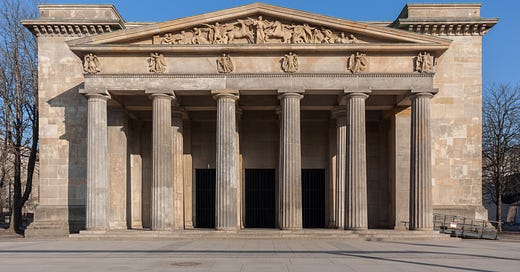“Here were Gods fighting Titans, and the viewer immediately sympathized with the nobler figures.”
In 1814 Johann Wolfgang von Goethe was asked to make suggestions for war scenes to be used in the memorial to the Wars of Liberation, alongside the sculptor Johann Gottfried Schadow. Following the construction public questions and controversy arose, and in 1817 Goethe responded with an essay entitled “A Challenge for a Modern Sculptor”. He asked, “How should the artist portray the victor and his defeated enemies as architectural adornment?” It is more difficult in modern times to portray such images as war is no longer fought between man and beast but between civilised nations.
How does an artist honour the conqueror? How does he include portrayals of both the victor and the defeated? It is significant that Goethe uses the word "honour", since art is not only a portrayal but the highest representation of a people, an event. The victor cannot merely be portrayed, his act, his being, includes an inheritance. And in the defeated we see the utmost struggle of a people, what is incomprehensible and yet grasped for a moment.
In the conflict of man and beast, the grand battles of civilised nations we are today reminded of Schmitt's friend-enemy distinction. When the opponents in a war cannot be distinguished how can they be honoured? Friend and enemy were autochthonous in the Greek world, primordial and unmistakable. For us they lose distinction, become elemental, a quintessential form. We are also reminded here of Herder’s statement that man surpasses war, and so the images of war are no longer sufficient in themselves.
“The Greeks, whom we must always revere as our masters, were able to lend such representations immediate interest by the very contrast between the opponents.” Heroes in combat with monsters, Titans in combat with Olympians – no uniforms are needed, the enemies are distinguished by what is natural to them, inborn. They are more distinct from one another than the species or genera. One sympathizes with the noble gods.
Nevertheless, absolute distinction does not limit the struggle, it is instead heightened, and remains until the last moment. We see this in Alcyoneus, a giant who can never be killed within his realm, Heracles must drag him a great distance and slay him beyond all borders. How might one represent such movement and struggle? It is a powerful form that confronts us across time in the myths and great confrontations of men. One image was left to us by the Greeks with Laocoön and his Sons, another with the Pergamon Altar, one of the few depictions of the war of the gods and giants. "The artist usually made the scales of victory tip one way, then the other, letting victors and the vanquished change roles, and yet we are always inclined to side with the vigorous race of heroes."
The paintings of centaurs also come to mind, in which war is a mark of creation, appropriation, rebirth, and the end. There is brutality in the struggle, but we do not think of it, there is too much greatness, too much at stake. Nature moves the battle forward and is in turn moved by it. The centaurs retreat into the forest, rear towards the sky before collapsing; the giants sink into the earth, but even as they are executed they threaten to take the sky down with them.
A much different image forms when men fight weaker opponents such as the Amazons. “Although these heroic women are strong and daring, they are still seen as the weaker sex and arouse our compassion as soon as they appear defeated, wounded or dead.”
Goethe refers to the Bacchantes and Fauns warring against the Tyrrhenians, and the Monument of Lysicrates. Here the enemies were driven as if by hunters over a cliff, and plunging into the sea were transformed into dolphins.




